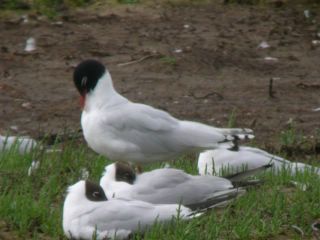 Apparently they are this approachable in the States. Anyway, he brightened up winter visits to this reserve.
Apparently they are this approachable in the States. Anyway, he brightened up winter visits to this reserve.
Saturday, December 24, 2005
Is Woody wild?
 Apparently they are this approachable in the States. Anyway, he brightened up winter visits to this reserve.
Apparently they are this approachable in the States. Anyway, he brightened up winter visits to this reserve.
Monday, December 19, 2005
Divers and Laughing Gull at Porthcawl
 We moved on to Porthcawl to find the Laughing Gull. I wanted some better views and maybe a photo or two. It was a UK tick for Jeff. We parked at the harbour, and scanned the flagpoles and beach. Sure enough, within a minute Jeff had picked out a dark blob on Sandy Bay which turned out to be 'our bird'. We got onto the beach and took a few photos before it flew back to the harbour, whereupon it returned to the beach as we arrived back at the harbour. Not too worry though, as we were able to watch it in flight and feeding on the beach for quite some time as the tide went out.
A couple of Gwent birders were there too, and mentioned they'd seen upto twenty Red-throated Divers and sixty Golden Plovers at Rest Bay that morning.
We moved on to Porthcawl to find the Laughing Gull. I wanted some better views and maybe a photo or two. It was a UK tick for Jeff. We parked at the harbour, and scanned the flagpoles and beach. Sure enough, within a minute Jeff had picked out a dark blob on Sandy Bay which turned out to be 'our bird'. We got onto the beach and took a few photos before it flew back to the harbour, whereupon it returned to the beach as we arrived back at the harbour. Not too worry though, as we were able to watch it in flight and feeding on the beach for quite some time as the tide went out.
A couple of Gwent birders were there too, and mentioned they'd seen upto twenty Red-throated Divers and sixty Golden Plovers at Rest Bay that morning.
Monday, December 12, 2005
Slimbridge pays off
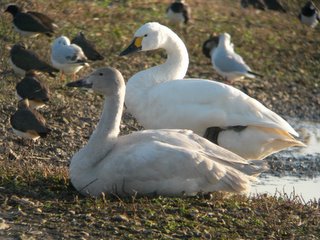 On to Holden Tower for the geese and who should be standing at the top of the stairs, Tim! Nice surprise. He'd managed to pick out the two Pink-footed Geese but the distance and light were proving difficult to keep tabs on them. A couple of active Peregrines and a mobile Dunlin flock didn't help to keep a focus of the geese. Plenty of White-fronted Geese were on show to help me creep towards 200. A very obliging Little Stint showed well amongst the Dunlin and I was nearly there.
We decided that the Zeiss Hide would offer a better view of the Geese. A false alarm on for a pink-foot was soon followed by the real thing as Tim picked out two Pink-footed Geese waddling out of a shallow pool. One very obligingly stick its pink foot out for us. Bird 200 for the year!
We made our way back, Tim to his driving lesson and me to the South Pool for some waders. Thsi proved fruitless though as the pool was very deep. Not to worry though ... mission accomplished!
On to Holden Tower for the geese and who should be standing at the top of the stairs, Tim! Nice surprise. He'd managed to pick out the two Pink-footed Geese but the distance and light were proving difficult to keep tabs on them. A couple of active Peregrines and a mobile Dunlin flock didn't help to keep a focus of the geese. Plenty of White-fronted Geese were on show to help me creep towards 200. A very obliging Little Stint showed well amongst the Dunlin and I was nearly there.
We decided that the Zeiss Hide would offer a better view of the Geese. A false alarm on for a pink-foot was soon followed by the real thing as Tim picked out two Pink-footed Geese waddling out of a shallow pool. One very obligingly stick its pink foot out for us. Bird 200 for the year!
We made our way back, Tim to his driving lesson and me to the South Pool for some waders. Thsi proved fruitless though as the pool was very deep. Not to worry though ... mission accomplished!
Friday, December 02, 2005
Stuff I missed
- Whimbrel - along the Gwent and Glamorgan coast on passage, but never managed to get out at the right time
- Puffin - missed the Skomer trip
- Spotted Crake - the Radipole bird hid from us
- Dotterel - we went too early for the Garreg Lwyd birds. They turned up a week after we went
- Ring Ouzel - somehow managed to miss the influx and the stragglers last month
- Wilson's Phalarope - I was stranded on the other side of the Solent
- Bee-eater - perhaps the dip of the year. Missed the Hampton Bishop pair the last open day of the view point. They reappeared later in the day
- Squacco Heron - stuck in work when Tim and Dan went
- Ring-billed Gull - the Cardiff Bay bird was never around when I was there. Could get one later possibly
- Red-necked Grebe - returning from holiday when it showed up in Kenfig
- Black Tern - didn't manage to get out when they were on passage through the area
- White-winged Black Tern - no time available to see the Weston bird
- Whiskered Tern - didn't know it was at CWP, but probably wouldn't have made it anyway
- Wood Sandpiper - none at Slimbridge or Goldcliff when we went after the Bee-eater dip
- Red-backed Shrike - no time to get to the Gower bird
- Grey Partridge - hoped for one on the New Forest trip and haven't searched the Vale
- Chough - haven't been West or searched Southerndown yet
- Little Stint - missed the main wader passage
- Temminck's Stint - ditto
- Baird's Sandpiper - ditto
- Turtle Dove - no chance!
- Tree Pipit - a shocking ommission
- Richard's Pipit - dipped the three at Huntspill on the Upland Sandpiper trip
- Firecrest - missed the birds at Portland and tried Kenfig North pool area without success
Thursday, December 01, 2005
196 - Laughing Gull
Monday, November 28, 2005
Bunting Bonanza
 Jeff, Lilly and I made the trip to Werfa on Sunday morning. After a short walk along the frozen track Lilly flushed a very confiding Snow Bunting. This one looked like a first-winter bird, probably female. It was very confiding and even walked towards us to within about 15 feet.
Jeff, Lilly and I made the trip to Werfa on Sunday morning. After a short walk along the frozen track Lilly flushed a very confiding Snow Bunting. This one looked like a first-winter bird, probably female. It was very confiding and even walked towards us to within about 15 feet.
 After about 20 minutes watching and photographing the bird we moved on in search of the Lapland Bunting. There was no sign of it after about an hour searching in its previous local. We had great views over Blaengarw and down towards Bridgend at the coast though. As we made our way back up the hill towards the mast we saw four birders in the distance. They too were searching for the bunting to no avail. Then, as we approached, they signalled that they were on the bird, only about 15 feet in front of them. We were soon on it too, and got fantastic views. Jeff took loads of photos.
These two birds now take me to 195 for the year.
After about 20 minutes watching and photographing the bird we moved on in search of the Lapland Bunting. There was no sign of it after about an hour searching in its previous local. We had great views over Blaengarw and down towards Bridgend at the coast though. As we made our way back up the hill towards the mast we saw four birders in the distance. They too were searching for the bunting to no avail. Then, as we approached, they signalled that they were on the bird, only about 15 feet in front of them. We were soon on it too, and got fantastic views. Jeff took loads of photos.
These two birds now take me to 195 for the year.
Friday, November 18, 2005
Hybrid duck, Kenfig 17th November
 Whilst waiting for a Bittern to show at Kenfig (which it did eventually), this interesting beast drifted around in front of the hide. The local experts think it's a Pochard x Ferruginous hybrid. It is superficially similar to a Redhead, but I am sure that it is NOT the bird that some of us saw in September, and believe to be the Redhead.
Whilst waiting for a Bittern to show at Kenfig (which it did eventually), this interesting beast drifted around in front of the hide. The local experts think it's a Pochard x Ferruginous hybrid. It is superficially similar to a Redhead, but I am sure that it is NOT the bird that some of us saw in September, and believe to be the Redhead.
Monday, November 14, 2005
Smew Lisvane Res 13th November
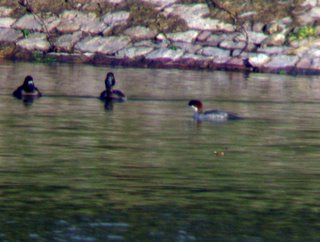
Having seen the Cornish Upland Sandpiper in October, I decided not to join the lads on the journey to Somerset.
I was sitting in front of the PC before 9am, with a hot cup of tea, when a Smew was reported on Birdguides, at Lisvane Reservoir, about 10mins from home. Leaving my tea undrunk, and Gill dozing in bed, I drove straight up there, bumped into Phil Bristow, who had reported the bird, a within a minute I was watching and photographing it.
Drove home to find Gill still dozing and my tea still warm. My kind of birding!
Sunday, November 13, 2005
Upland Sandpiper in Somerset
Saturday, November 12, 2005
Ogmore
 Jeff and I spent a couple of hours on the Ogmore. A quick scan at Watermill gave just the usuall Black-headed Gulls, the odd Pheasant and a distant Little Egret. We moved on to Portobello and walked along the river. A Kingfisher was surpisingly close to the river mouth, but little else was of note.
At the estuary, we were soon on to a small party of Turnstones and Purple Sandpipers. There were about a dozen sandpipers on view, and we managed to get in close for terrific views.
Jeff and I spent a couple of hours on the Ogmore. A quick scan at Watermill gave just the usuall Black-headed Gulls, the odd Pheasant and a distant Little Egret. We moved on to Portobello and walked along the river. A Kingfisher was surpisingly close to the river mouth, but little else was of note.
At the estuary, we were soon on to a small party of Turnstones and Purple Sandpipers. There were about a dozen sandpipers on view, and we managed to get in close for terrific views.
Thursday, November 10, 2005
Long Tailed Duck, Lamby Way Lake, 6th November
Laughing Gull, 5th November, Watermill, Ogmore
Monday, October 24, 2005
Prediction - 210 for 2005!
- Red-throated Diver
- Bewick's Swan
- Whooper Swan
- White-fronted Goose
- Pink-footed Goose
- Smew
- Marsh Harrier
- Purple Sandpiper
- Jack Snipe
- Black Redstart
- Willow Tit
- Marsh Tit
- Crossbill
190
Saturday, October 15, 2005
Squacco, Newton Abbott, 11th October


 Dan and I twitched this stupidly approachable bird in a town centre park. We thought it had gone, because when we arrived, the only birder present was stood some distance from his scope, hands in pocket. As we got nearer, we realised that the bird was about 30 feet from him (and us!), on the wall around the pond. Dipped on Cirls at Exminster, however........
Dan and I twitched this stupidly approachable bird in a town centre park. We thought it had gone, because when we arrived, the only birder present was stood some distance from his scope, hands in pocket. As we got nearer, we realised that the bird was about 30 feet from him (and us!), on the wall around the pond. Dipped on Cirls at Exminster, however........
Monday, October 10, 2005
Portland Weekend
Sunday, October 09, 2005
Isles of Scilly, 6th October
 Whilst in Cornwall, a £20 day trip from Penzance to St Marys on the Scillonian brought me 3 "lifers" and 2 year ticks.
Spotted Sandpiper (shown), Sora and Blackpoll Warbler all showed well, and Yellow Browed Warbler and Jack Snipe were welcome bonuses!
I still had time to pop to a couple of pubs.
Sea watching was poor, just a couple of Bonxies and Stormies on a calm day.
Gill enjoyed clothes and art shopping in St Ives, so a good day was had by all.
Whilst in Cornwall, a £20 day trip from Penzance to St Marys on the Scillonian brought me 3 "lifers" and 2 year ticks.
Spotted Sandpiper (shown), Sora and Blackpoll Warbler all showed well, and Yellow Browed Warbler and Jack Snipe were welcome bonuses!
I still had time to pop to a couple of pubs.
Sea watching was poor, just a couple of Bonxies and Stormies on a calm day.
Gill enjoyed clothes and art shopping in St Ives, so a good day was had by all.
Long Billed Dowitcher, Drift Res, Cornwall. 2nd October
Thursday, September 29, 2005
Grey Phalarope at Nantyffyllon 28th Sept
Tuesday, September 27, 2005
178
Saturday, September 24, 2005
Little Crake at Slimbridge
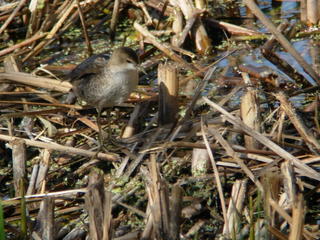 Anyway, I managed to take a handful of record shots, which is my first serious attempt at digiscoping. It was extremely difficult in a full hide with lots of movement, but this one is okay.
A little later in the day, I returned to the Lathbury Hide and was rewarded with great views of the bird out in the open. The day was rounded off by two Curlew Sandpipers on the South Lake. So one lifer and a year tick for me today. Now for that Redhead!
Anyway, I managed to take a handful of record shots, which is my first serious attempt at digiscoping. It was extremely difficult in a full hide with lots of movement, but this one is okay.
A little later in the day, I returned to the Lathbury Hide and was rewarded with great views of the bird out in the open. The day was rounded off by two Curlew Sandpipers on the South Lake. So one lifer and a year tick for me today. Now for that Redhead!
Monday, September 05, 2005
Pembroke Dock-Rosslare-Pembroke Dock
 We made our way up on the top deck about half an hour before getting into Rosslare. That was worth it, as the boat started churning the water up, attracting loads of birds, including adult Mediterranean Gull, adult and immature Kittiwakes, Sandwich and Common Terns. We spent a couple of hours in the ferry terminal, picking up Manx Shearwaters, two Artic Skuas, more terns and a few Razorbills.
On leaving at 08:45am, we went straight up on the top deck. It proved to be too windy for 'scopes to be useful, but it didn't matter as the birds were close enough to see easily with binoculars. We got a nice Pomarine Skua, 100s, perhaps 1000s, of Manx Shearwaters, 100s of Gannets, a really nice Great Skua, 3 distant Storm-petrels, Guillemots, Razorbills and flocks of 'Commic' Terns which were just too distant to pin down to either Common or Arctic. To cap it all though, was a Cory's Shearwater, which was a lifer for me. Jeff managed to see a Minke Whale too, but I missed it. We got back to Pembroke Dock at 13:00, so we had a good 4 hours seawatching. The sense of anticipation as you travel is great, as you're watching birds almost constantly, and there's a real sense that something good is coming next. Even if a rarity doesn't come up though its still so good to see so many of these birds in their element.
I'm sure we'll go again. The great thing is that it can be organized right at the last minute when you know the birds are around and the conditions will be favourable.
We made our way up on the top deck about half an hour before getting into Rosslare. That was worth it, as the boat started churning the water up, attracting loads of birds, including adult Mediterranean Gull, adult and immature Kittiwakes, Sandwich and Common Terns. We spent a couple of hours in the ferry terminal, picking up Manx Shearwaters, two Artic Skuas, more terns and a few Razorbills.
On leaving at 08:45am, we went straight up on the top deck. It proved to be too windy for 'scopes to be useful, but it didn't matter as the birds were close enough to see easily with binoculars. We got a nice Pomarine Skua, 100s, perhaps 1000s, of Manx Shearwaters, 100s of Gannets, a really nice Great Skua, 3 distant Storm-petrels, Guillemots, Razorbills and flocks of 'Commic' Terns which were just too distant to pin down to either Common or Arctic. To cap it all though, was a Cory's Shearwater, which was a lifer for me. Jeff managed to see a Minke Whale too, but I missed it. We got back to Pembroke Dock at 13:00, so we had a good 4 hours seawatching. The sense of anticipation as you travel is great, as you're watching birds almost constantly, and there's a real sense that something good is coming next. Even if a rarity doesn't come up though its still so good to see so many of these birds in their element.
I'm sure we'll go again. The great thing is that it can be organized right at the last minute when you know the birds are around and the conditions will be favourable.
Little Gull in the Bay
Tuesday, August 30, 2005
What I missed!
 The second week was spent on the Isle of Wight, and naturally enough this is when the birds appeared. On the very day I left! Tim managed to catch up with a Spotted Crake, a Kentish Plover and a Wryneck, but most cruel of all was a Wilson's Phalarope at Farlington Marshes in Portsmouth. So near, yet so far! And to cap it all a Red-necked Grebe turned up for a day at Kenfig NNR while I was busy driving home.
I did manage to brush-up on my tern identification skills however, enjoying great views of both Common and Sandwich Terns fishing along the beach at Shanklin all week.
The second week was spent on the Isle of Wight, and naturally enough this is when the birds appeared. On the very day I left! Tim managed to catch up with a Spotted Crake, a Kentish Plover and a Wryneck, but most cruel of all was a Wilson's Phalarope at Farlington Marshes in Portsmouth. So near, yet so far! And to cap it all a Red-necked Grebe turned up for a day at Kenfig NNR while I was busy driving home.
I did manage to brush-up on my tern identification skills however, enjoying great views of both Common and Sandwich Terns fishing along the beach at Shanklin all week.
Thursday, August 11, 2005
Slimbridge 10th August
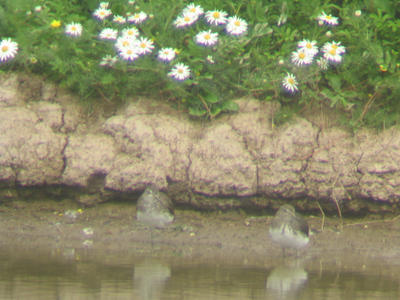 That morning I had been up to the West Midlands to collect my mother for a short visit to sunny Cardiff, and on our way back, we called at Slimbridge to see what passage waders we could find for her year list.
There were many Green Sandpipers (as shown), a few Ruff, and a Spotted Redshank.
We also called at Goldcliff, where a few Avocets remained, and a Spoonbill, more Green Sandpipers, a couple of Common Sandpipers and Greenshanks were present.
That morning I had been up to the West Midlands to collect my mother for a short visit to sunny Cardiff, and on our way back, we called at Slimbridge to see what passage waders we could find for her year list.
There were many Green Sandpipers (as shown), a few Ruff, and a Spotted Redshank.
We also called at Goldcliff, where a few Avocets remained, and a Spoonbill, more Green Sandpipers, a couple of Common Sandpipers and Greenshanks were present.
Saturday, August 06, 2005
... and now its 170
Tuesday, August 02, 2005
List smashes the 160 barrier!
- 40 - Work
- 70 - Rhondda Cynon Taf
- 99 - East Glamorgan
- 122 - Glamorgan
- 127 - Wales
- 168 - UK
Monday, August 01, 2005
Dipped
We headed off to Slimbridge in the hope of a Wood Sandpiper and Little Stint. Neither of these were around, but we enjoyed Ruff in a variety of plumage patterns, along with numerous Green Sandpipers, Black-tailed Godwits in various stages of moult, Common Terns with young, Spotted Redshanks and a few other commoner species.
We returned across the Severn, stopping off at a wet Goldcliff in the hope of that elusive Wood Sandpiper. It was quiet here too, and even the Avocets were missing. Plenty of Little Egrets and eclipse Shelducks were around though, along with a small party of Dunlins, a Ruff, a Greenshank and a couple of juvenile Yellow Wagtails.
So this was not the best days birding we've had, but its nice to get out, and we watched some nice birds after all, including a couple of year ticks.
The day concluded however, with news from BirdGuides (once we were home, of course) that the Bee-eaters had returned late afternoon. As I write, they are there once more. A midweek trip to Hereford is on the cards.
Wednesday, July 27, 2005
BirdGuides Success
Tuesday, July 26, 2005
Bee-eaters in Herefordshire
Monday, July 04, 2005
Devon Dash
Thursday, June 23, 2005
Listing Update
- 40 - Work
- 70 - Rhondda Cynon Taf
- 98 - East Glamorgan
- 121 - Glamorgan
- 126 - Wales
- 158 - UK
White Storks in Somerset
Collared Pratincole at National Wetlands Centre
Tuesday, June 14, 2005
Skomer 12th June 2005

Friday, June 10, 2005
Nightjars .... and Car Trouble
Tuesday, June 07, 2005
Flycatchers
Tuesday, May 24, 2005
New Forest Trip
Wednesday, May 18, 2005
Lists ... lists ... lists
- 40 - Work
- 66 - Rhondda Cynon Taf
- 94 - East Glamorgan
- 117 - Glamorgan
- 120 - Wales
- 145 - UK
Friday, February 25, 2005
A few birds of New Zealand (and a honeymoon!)
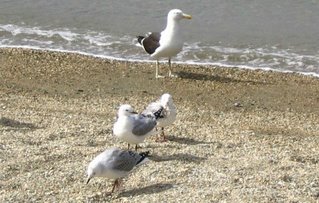 From the small water taxi, new species were rapidly added. Pied and Variable Oystercatchers, Spotted and Pied Shag, our Cormorant, Australasian Gannet, White Fronted Tern, Australasian Harrier (a very common bird), Fluttering Shearwater and finally, as we approached the resort, an Arctic Skua.
From the jetty, our friendly ferryman pointed out a Stingray a few feet away, very impressive. The resort was on a wooded hillside, and we had a stunning balcony view over the bay from our lodge. A large brown bird, like a cross between a water rail and a chicken was wandering around a few yards away. It was our first flightless bird, a Weka.
From the small water taxi, new species were rapidly added. Pied and Variable Oystercatchers, Spotted and Pied Shag, our Cormorant, Australasian Gannet, White Fronted Tern, Australasian Harrier (a very common bird), Fluttering Shearwater and finally, as we approached the resort, an Arctic Skua.
From the jetty, our friendly ferryman pointed out a Stingray a few feet away, very impressive. The resort was on a wooded hillside, and we had a stunning balcony view over the bay from our lodge. A large brown bird, like a cross between a water rail and a chicken was wandering around a few yards away. It was our first flightless bird, a Weka.

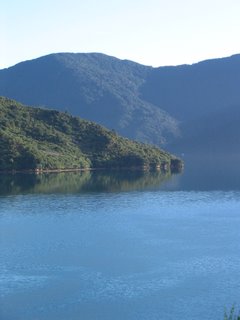 The following morning (3rd), slightly jet lagged, we decided to have a gentle stroll through the sub tropical rainforest that surrounded us, to the next resort, Endeavour, about 7 miles away. This is part of the popular Queen Charlotte Track.
The noise from the cicadas was quite intrusive to start with, but we soon got used to it. In the warm sunshine (approx 25C), many small birds were soon flitting around. Flocks of Silvereye,with a Siskin-like call were abundant, Tui (shown),
The following morning (3rd), slightly jet lagged, we decided to have a gentle stroll through the sub tropical rainforest that surrounded us, to the next resort, Endeavour, about 7 miles away. This is part of the popular Queen Charlotte Track.
The noise from the cicadas was quite intrusive to start with, but we soon got used to it. In the warm sunshine (approx 25C), many small birds were soon flitting around. Flocks of Silvereye,with a Siskin-like call were abundant, Tui (shown),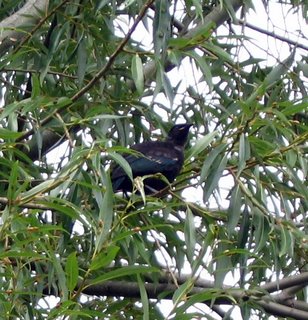 with a Nightingale-like song and the bulky New Zealand Pigeon (a greenish version of our Wood Pigeon).
with a Nightingale-like song and the bulky New Zealand Pigeon (a greenish version of our Wood Pigeon).
 We were most impressed with Fantails, looking a bit like a cross between a Long Tailed Tit and a Dartford Warbler. They dance around on branches, tails spread wide. Apparently they use the tails as radars, helping the birds to locate the flies they feed on. Both Pied and Black varieties were seen.
Bellbirds were seen, and a thin reedy song was heard from nearby. It reminded us of an old man whistling. Eventually we found the source, a Grey Warbler, an abundant bird, and NZ’s only warbler. Chaffinches were also seen. Arriving at Endeavour, we had a couple of hours to wait for the boat back across the bay to Punga, which was spent sitting in the sun sampling the local beers and watching more Australasian Harriers and many of the small birds already seen.
The 4th was cooler and cloudy, which was useful as we had a fair bit of walking to do, and an “Eco tour” boat to catch in the afternoon.
We soon climbed away from the shoreline, through a small area of scrub where Linnets, Greenfinches and Tom Tits were seen, and into pine forest, where Brown Creepers were found. Soon a familiar “sewing machine” call was heard overhead. Decent views of the birds concerned revealed Mealy Redpoll, which turned out to be one of the most common birds in NZ !
After four and half hours brisk walking, we arrived at the Bay of Many Coves Resort, with a few minutes to spare before our eco tour collected us, just enough time the see more Weka, a local Kingfisher, greener than ours; and the uncommon Reef Heron, amongst more Pied and Spotted Shags.
The main aim of the boat trip was to look for Hector’s Dolphins, the world smallest (4ft) and rarest dolphin. We were lucky enough to have close views of a group of about ten of these lovely creatures. Soon afterwards, we passed a small bird resting on the water, I absent-mindedly thought Guillemot, until I pulled myself together, remembering there are none there, it was a Little Blue Penguin!
We were most impressed with Fantails, looking a bit like a cross between a Long Tailed Tit and a Dartford Warbler. They dance around on branches, tails spread wide. Apparently they use the tails as radars, helping the birds to locate the flies they feed on. Both Pied and Black varieties were seen.
Bellbirds were seen, and a thin reedy song was heard from nearby. It reminded us of an old man whistling. Eventually we found the source, a Grey Warbler, an abundant bird, and NZ’s only warbler. Chaffinches were also seen. Arriving at Endeavour, we had a couple of hours to wait for the boat back across the bay to Punga, which was spent sitting in the sun sampling the local beers and watching more Australasian Harriers and many of the small birds already seen.
The 4th was cooler and cloudy, which was useful as we had a fair bit of walking to do, and an “Eco tour” boat to catch in the afternoon.
We soon climbed away from the shoreline, through a small area of scrub where Linnets, Greenfinches and Tom Tits were seen, and into pine forest, where Brown Creepers were found. Soon a familiar “sewing machine” call was heard overhead. Decent views of the birds concerned revealed Mealy Redpoll, which turned out to be one of the most common birds in NZ !
After four and half hours brisk walking, we arrived at the Bay of Many Coves Resort, with a few minutes to spare before our eco tour collected us, just enough time the see more Weka, a local Kingfisher, greener than ours; and the uncommon Reef Heron, amongst more Pied and Spotted Shags.
The main aim of the boat trip was to look for Hector’s Dolphins, the world smallest (4ft) and rarest dolphin. We were lucky enough to have close views of a group of about ten of these lovely creatures. Soon afterwards, we passed a small bird resting on the water, I absent-mindedly thought Guillemot, until I pulled myself together, remembering there are none there, it was a Little Blue Penguin!
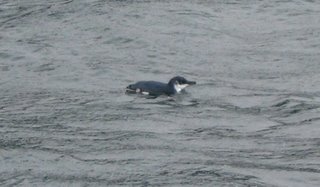
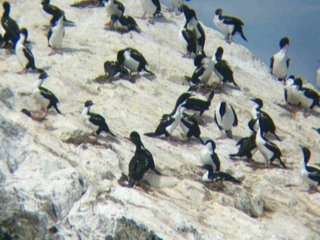
 The boat then took us to see one of the few nesting colonies of King Shag, apparently the world’s rarest cormorant. 30-40 birds were present on “White Rock”, so called because of the guano. We passed through a very large flock of Fluttering Shearwaters, and a single Fairy Prion was seen. The boat stopped briefly at Motorua Island, and we had just enough time to visit a water hole, where we were lucky enough to see a family of Saddlebacks, one of the worlds rarest birds, and now only found on offshore, predator free islands. A NZ Robin was also present. We were dropped back at Bay of Many Coves Resort, and used the hour before our boat home to sample some more local beers.
On the 5th we retraced our steps to Endeavour and carried on further to Resolution, to catch a water taxi home (15 miles in 30C heat, I thought this was a holiday!). The only new species was the first of many White Faced Herons. That evening, we heard a Morepork (similar to a Tawny Owl) very close to our lodge.
We now packed our belongings and spent most of the 6th travelling to Queenstown in the SW of South Island. A water taxi (with a detour to see a fur seal)
The boat then took us to see one of the few nesting colonies of King Shag, apparently the world’s rarest cormorant. 30-40 birds were present on “White Rock”, so called because of the guano. We passed through a very large flock of Fluttering Shearwaters, and a single Fairy Prion was seen. The boat stopped briefly at Motorua Island, and we had just enough time to visit a water hole, where we were lucky enough to see a family of Saddlebacks, one of the worlds rarest birds, and now only found on offshore, predator free islands. A NZ Robin was also present. We were dropped back at Bay of Many Coves Resort, and used the hour before our boat home to sample some more local beers.
On the 5th we retraced our steps to Endeavour and carried on further to Resolution, to catch a water taxi home (15 miles in 30C heat, I thought this was a holiday!). The only new species was the first of many White Faced Herons. That evening, we heard a Morepork (similar to a Tawny Owl) very close to our lodge.
We now packed our belongings and spent most of the 6th travelling to Queenstown in the SW of South Island. A water taxi (with a detour to see a fur seal) 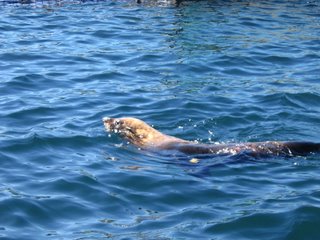 and three flights later, we were able to sit on the balcony of our B and B “5 Star Lane”, a superb modern building with splendid lake and mountain views, run by a friendly and efficient South African couple, Ray and Merlin Sansom. After home made scones and tea, we walked into town and found Dunnock and Yellowhammers in gardens nearby, and Great Crested Grebes, Grey Duck (shown) and New Zealand Scaup on Lake Wakatipo.
and three flights later, we were able to sit on the balcony of our B and B “5 Star Lane”, a superb modern building with splendid lake and mountain views, run by a friendly and efficient South African couple, Ray and Merlin Sansom. After home made scones and tea, we walked into town and found Dunnock and Yellowhammers in gardens nearby, and Great Crested Grebes, Grey Duck (shown) and New Zealand Scaup on Lake Wakatipo. 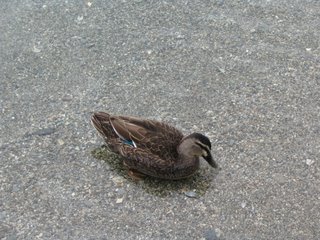 After spending the 7th resting and being tourists around Queenstown, we packed up again on the 8th, a warm sunny morning, and caught a bus for an hour to the beginning of one of NZs best known tramps, the Routeburn. This walk is 28 miles, beginning and ending in forest, and climbing through alpine scenery higher than anywhere in the UK. We had booked to spend 3 nights staying in mountain huts en route, and would have to carry approx 25lb each (food and cooking utensils, clothes, sleeping bags, and a small telescope!) From the bus we saw Black Swans and Australian Magpies (a normal corvoid shape, unlike our magpie). We started the walk amongst forest and soon were surrounded by the charismatic Riflemen, NZs smallest bird, similar to a Goldcrest, but moving more like a Treecreeper. We climbed alongside a spectacular gorge and eventually emerged at Routeburn Flats Hut, where a river meandered through meadows surrounded by mountains of over 6000ft, some of which held small glaciers.
After spending the 7th resting and being tourists around Queenstown, we packed up again on the 8th, a warm sunny morning, and caught a bus for an hour to the beginning of one of NZs best known tramps, the Routeburn. This walk is 28 miles, beginning and ending in forest, and climbing through alpine scenery higher than anywhere in the UK. We had booked to spend 3 nights staying in mountain huts en route, and would have to carry approx 25lb each (food and cooking utensils, clothes, sleeping bags, and a small telescope!) From the bus we saw Black Swans and Australian Magpies (a normal corvoid shape, unlike our magpie). We started the walk amongst forest and soon were surrounded by the charismatic Riflemen, NZs smallest bird, similar to a Goldcrest, but moving more like a Treecreeper. We climbed alongside a spectacular gorge and eventually emerged at Routeburn Flats Hut, where a river meandered through meadows surrounded by mountains of over 6000ft, some of which held small glaciers.  After claiming our bunks, and trying out the “long drop” lavatories, we strolled through the forest adjacent to the hut and found a Yellow Crowned Parakeet, which we tracked down by its harsh call. Almost immediately we encountered a small flock of Yellowheads, a declining passerine species. Delighted with these sighting, we headed back as a New Zealand Falcon flew low over the treetops. This rare species is similar to a small brownish Peregrine, and we had another sighting that evening, 30 yards from us as we studied pictures of it in our Fieldguide.
After a reasonable night in our dormitory, we set off on the 9th for a long climb over the Harris Saddle in cooler, drizzly weather. As we climbed above 3000ft, the lush forest abruptly gave way to Alpine plants, and a bleaker landscape. The only birds for a while were Dunnocks, Yellowhammers and Mealy Redpoll, until we heard a harsh cry, not unlike a Chough. We immediately looked up to see three Keas flying in front of a cliff face. The world’s only alpine parrot is common in these surroundings and was one of the most eagerly anticipated birds of the trip. A long and slippery descent brought us wearily to the McKenzie Hut, next to a beautiful lake and surrounded by stunning mountain scenery.
After claiming our bunks, and trying out the “long drop” lavatories, we strolled through the forest adjacent to the hut and found a Yellow Crowned Parakeet, which we tracked down by its harsh call. Almost immediately we encountered a small flock of Yellowheads, a declining passerine species. Delighted with these sighting, we headed back as a New Zealand Falcon flew low over the treetops. This rare species is similar to a small brownish Peregrine, and we had another sighting that evening, 30 yards from us as we studied pictures of it in our Fieldguide.
After a reasonable night in our dormitory, we set off on the 9th for a long climb over the Harris Saddle in cooler, drizzly weather. As we climbed above 3000ft, the lush forest abruptly gave way to Alpine plants, and a bleaker landscape. The only birds for a while were Dunnocks, Yellowhammers and Mealy Redpoll, until we heard a harsh cry, not unlike a Chough. We immediately looked up to see three Keas flying in front of a cliff face. The world’s only alpine parrot is common in these surroundings and was one of the most eagerly anticipated birds of the trip. A long and slippery descent brought us wearily to the McKenzie Hut, next to a beautiful lake and surrounded by stunning mountain scenery.  With rain and high winds forecast on the 10th, after passing spectacular waterfalls we briskly walked to the next destination, the Howden Hut by lunchtime, and in the afternoon we explored local forest, examining the flowers and mosses that abound in them.
After another exciting rehydrated meal, it rained all night and into the morning, and we lingered as long as possible after breakfast on the 11th, before braving the elements for 90 minute walk to the road at the Divide to catch a bus to Milford Sound, a world famous fiord where we had booked a boat trip. When our bus eventually arrived, we were cold and wet, and were somewhat dismayed to discover that we were the only walkers with the remaining passengers being well dressed American and Japanese tourists!
Milford Sound in torrential rain was amazing, with waterfalls spontaneously spilling over sheer drops.
With rain and high winds forecast on the 10th, after passing spectacular waterfalls we briskly walked to the next destination, the Howden Hut by lunchtime, and in the afternoon we explored local forest, examining the flowers and mosses that abound in them.
After another exciting rehydrated meal, it rained all night and into the morning, and we lingered as long as possible after breakfast on the 11th, before braving the elements for 90 minute walk to the road at the Divide to catch a bus to Milford Sound, a world famous fiord where we had booked a boat trip. When our bus eventually arrived, we were cold and wet, and were somewhat dismayed to discover that we were the only walkers with the remaining passengers being well dressed American and Japanese tourists!
Milford Sound in torrential rain was amazing, with waterfalls spontaneously spilling over sheer drops.
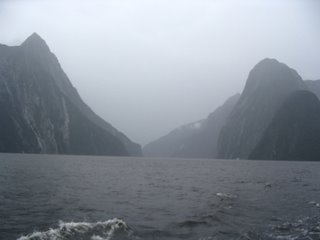
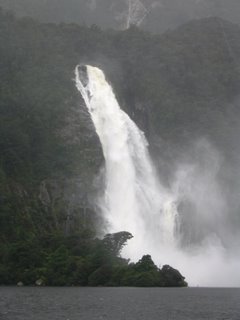 Mitre Peak, over 5000ft high was hazily visible, dropping nearly vertically to the sea. We were very glad of the unlimited tea supplies to warm us up. Wildlife was not abundant, but more gulls, White Fronted Terns, Fur Seals, and a pod of about ten Bottlenosed Dolphins were seen. The bus then took us to the small modern town of Te Anau, with the birding highlight being Paradise Shelduck on a roadside pool.
Rarely has a shower and a good meal been so welcome after 3 nights in huts with no showers and basic provisions.
The 12th was dry, though the mountains were in mist, and after stocking up with food, we set off to walk the Kepler Track, 39 miles in 3 days, again with heavy packs.
The walk started by taking us through a bird collection, where a couple of captive Takahe were present. These Shelduck sized flightless rails were thought extinct from 1900 to 1948, until rediscovered high in mountains near Te Anau. Access to an entire mountain range the size of about a third of Wales is forbidden, except for a few researchers, to protect habitat for this and other threatened species.
As we left the collection, we found one of the highlights of the trip, a Shining Cuckoo. The closest European bird for size and behaviour would probably be a Wryneck, but with a metallic green back, and a Barred Warblerish pattern on the front. Stunning!
Mitre Peak, over 5000ft high was hazily visible, dropping nearly vertically to the sea. We were very glad of the unlimited tea supplies to warm us up. Wildlife was not abundant, but more gulls, White Fronted Terns, Fur Seals, and a pod of about ten Bottlenosed Dolphins were seen. The bus then took us to the small modern town of Te Anau, with the birding highlight being Paradise Shelduck on a roadside pool.
Rarely has a shower and a good meal been so welcome after 3 nights in huts with no showers and basic provisions.
The 12th was dry, though the mountains were in mist, and after stocking up with food, we set off to walk the Kepler Track, 39 miles in 3 days, again with heavy packs.
The walk started by taking us through a bird collection, where a couple of captive Takahe were present. These Shelduck sized flightless rails were thought extinct from 1900 to 1948, until rediscovered high in mountains near Te Anau. Access to an entire mountain range the size of about a third of Wales is forbidden, except for a few researchers, to protect habitat for this and other threatened species.
As we left the collection, we found one of the highlights of the trip, a Shining Cuckoo. The closest European bird for size and behaviour would probably be a Wryneck, but with a metallic green back, and a Barred Warblerish pattern on the front. Stunning!
 We walked for six miles around the head of Lake Te Anau, and scrubby bushland gave way to more forest.
We walked for six miles around the head of Lake Te Anau, and scrubby bushland gave way to more forest.

 No additional species were seen, but a lot more Mealy Redpoll everywhere, and more Yellow Crowned Parakeets were seen high in treetops. We eventually began climbing, and just above 3000ft, we entered the alpine zone in mist. The tree line was very sudden everywhere we went, literally a few yards of transition only, from thick forest to open mountainside. We soon reached the Luxmoore Hut, at about the height of Snowdon, where another interesting rehydrated meal was “enjoyed”.
The 13th dawned bright and clear, and the superb view was enjoyed, as were close up views of 3 Kea on the balcony of the hut, before breakfast.
As we climbed away from the hut, a Rock Wren was seen briefly. The group of Kea were waiting for us a bit further up, and posed for photographs with the stunning Murchison Mountains behind them
No additional species were seen, but a lot more Mealy Redpoll everywhere, and more Yellow Crowned Parakeets were seen high in treetops. We eventually began climbing, and just above 3000ft, we entered the alpine zone in mist. The tree line was very sudden everywhere we went, literally a few yards of transition only, from thick forest to open mountainside. We soon reached the Luxmoore Hut, at about the height of Snowdon, where another interesting rehydrated meal was “enjoyed”.
The 13th dawned bright and clear, and the superb view was enjoyed, as were close up views of 3 Kea on the balcony of the hut, before breakfast.
As we climbed away from the hut, a Rock Wren was seen briefly. The group of Kea were waiting for us a bit further up, and posed for photographs with the stunning Murchison Mountains behind them
 The rest of the day, over Mt Luxmoore (4829ft), and a long alpine ridge, was brilliant in the sunshine, but apart from displaying Keas (think of overexcited Chough or Raven tumbling and calling), birdless.
The rest of the day, over Mt Luxmoore (4829ft), and a long alpine ridge, was brilliant in the sunshine, but apart from displaying Keas (think of overexcited Chough or Raven tumbling and calling), birdless.

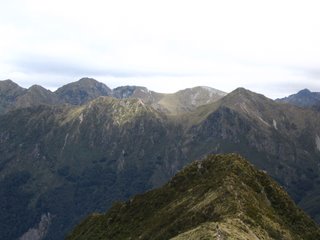 We dropped back down into forest and stayed the night in our last hut, the Iris Burn. The warden told us to listen for Brown Kiwi in the long grass overnight, and played us a recording of the calls. Torrential rain deterred us, however. Waking in the night, we clearly heard a male calling outside (unless the warden was standing outside in the rain with his CD player!)
Our plan for the 14th was straightforward, a 15mile walk down the valley, to catch the bus back to Te Anau. Luckily the rain stopped as we breakfasted, and we enjoyed our walk, although we didn’t find rare Blue Duck, as hoped. A brief detour to a small lake brought us our first NZ Pipit, a typical example of its family.
After another night in Te Anau, we caught an Intercity bus on the 15th down through mainly agricultural land to Invercargill on the south coast. As we travelled, more birds were seen, including Skylarks, several more Australasian Harriers, a Pukeko (aka Purple Swamp Hen), and surprisingly, a male Cirl Bunting, sat on wires at eye-level, a few feet away.
From Invercargill, we caught a small plane for the short flight across to our last destination, Stewart Island. There is only one small township on the Island, Oban or Half-Moon Bay. We were taken from the runway by minibus to the terminal shed (building is too grand a description), which is on the quayside, and doubles as the island Post Office. We were staying about 5 minutes walk away, but our friendly host, Ernie collected us and drove us around most of the islands roads. This took about 20 minutes!
Ernie has a keen interest in birds, and feeders were dotted about the garden. A male Tui was often seen coming to drink, and 2 Kaka, the forest equivalent of the Kea, were also hanging around the garden.
We walked through the township, around the bay, passing Variable Oystercatchers with a couple of chicks.
We dropped back down into forest and stayed the night in our last hut, the Iris Burn. The warden told us to listen for Brown Kiwi in the long grass overnight, and played us a recording of the calls. Torrential rain deterred us, however. Waking in the night, we clearly heard a male calling outside (unless the warden was standing outside in the rain with his CD player!)
Our plan for the 14th was straightforward, a 15mile walk down the valley, to catch the bus back to Te Anau. Luckily the rain stopped as we breakfasted, and we enjoyed our walk, although we didn’t find rare Blue Duck, as hoped. A brief detour to a small lake brought us our first NZ Pipit, a typical example of its family.
After another night in Te Anau, we caught an Intercity bus on the 15th down through mainly agricultural land to Invercargill on the south coast. As we travelled, more birds were seen, including Skylarks, several more Australasian Harriers, a Pukeko (aka Purple Swamp Hen), and surprisingly, a male Cirl Bunting, sat on wires at eye-level, a few feet away.
From Invercargill, we caught a small plane for the short flight across to our last destination, Stewart Island. There is only one small township on the Island, Oban or Half-Moon Bay. We were taken from the runway by minibus to the terminal shed (building is too grand a description), which is on the quayside, and doubles as the island Post Office. We were staying about 5 minutes walk away, but our friendly host, Ernie collected us and drove us around most of the islands roads. This took about 20 minutes!
Ernie has a keen interest in birds, and feeders were dotted about the garden. A male Tui was often seen coming to drink, and 2 Kaka, the forest equivalent of the Kea, were also hanging around the garden.
We walked through the township, around the bay, passing Variable Oystercatchers with a couple of chicks.
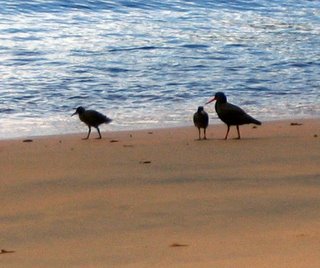
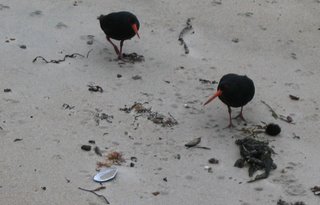 A large number of seabirds were visible distantly, so we decided to walk out to the headland at Akers Point, about a mile away, to get better views. There was a good selection, with Stewart Island Shags (pied and bronze phase) flying to and from a small island, White and Black Fronted Terns, hundreds of Sooty Shearwaters, and at least thirty of both Shy and Buller’s Mollymawks.
A large number of seabirds were visible distantly, so we decided to walk out to the headland at Akers Point, about a mile away, to get better views. There was a good selection, with Stewart Island Shags (pied and bronze phase) flying to and from a small island, White and Black Fronted Terns, hundreds of Sooty Shearwaters, and at least thirty of both Shy and Buller’s Mollymawks.  These are Gannet sized albatrosses, and very impressive. A Brown Skua passed, and a Little Blue Penguin sat on the sea, dived and disappeared!
An early start on the 16th was necessary, as we had booked an all day “eco tour” to Ulva Island, a small predator free island about a mile offshore. Our guide, Furhana, studied in Aberystwyth, and specialises in showing the whole range of flora and fauna on Ulva. Most of the birds were now very familiar to us, but Red Crowned Parakeets were new to us. The island has rat traps every 100 metres in a grid pattern across it. Periodically, a sterile rat is released, and if it is not trapped within a few days, more traps are laid. The Dept Of Conservation, who are heavily involved in all the areas we visited, are determined to keep predators off the island, as there are significant numbers of Saddleback and Yellowhead, both endangered species. We saw several of both species. Furhana gave us a lot of information on the trees and flowers present and showed us many of NZs 180 fern species. The island is one of the best preserved primeaval forests anywhere in the world, and hasn’t changed significantly in millions of years. We also found kiwi feathers and holes where one had been hunting recently. A memorable day.
The morning of the 17th was showery, so a leisurely wander around Oban kept us dry. With improving weather, we hired a glass bottomed water taxi for the afternoon, and were taken to see green-lipped mussel beds. More Mollymawks flew close by
These are Gannet sized albatrosses, and very impressive. A Brown Skua passed, and a Little Blue Penguin sat on the sea, dived and disappeared!
An early start on the 16th was necessary, as we had booked an all day “eco tour” to Ulva Island, a small predator free island about a mile offshore. Our guide, Furhana, studied in Aberystwyth, and specialises in showing the whole range of flora and fauna on Ulva. Most of the birds were now very familiar to us, but Red Crowned Parakeets were new to us. The island has rat traps every 100 metres in a grid pattern across it. Periodically, a sterile rat is released, and if it is not trapped within a few days, more traps are laid. The Dept Of Conservation, who are heavily involved in all the areas we visited, are determined to keep predators off the island, as there are significant numbers of Saddleback and Yellowhead, both endangered species. We saw several of both species. Furhana gave us a lot of information on the trees and flowers present and showed us many of NZs 180 fern species. The island is one of the best preserved primeaval forests anywhere in the world, and hasn’t changed significantly in millions of years. We also found kiwi feathers and holes where one had been hunting recently. A memorable day.
The morning of the 17th was showery, so a leisurely wander around Oban kept us dry. With improving weather, we hired a glass bottomed water taxi for the afternoon, and were taken to see green-lipped mussel beds. More Mollymawks flew close by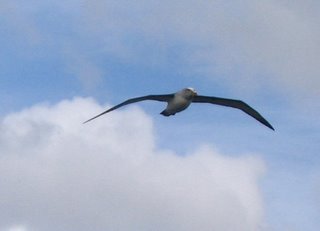 , and our captain pointed out 2 Yellow Eyed Penguins. We also visited a salmon farm, where Stewart Island Shags loitered for scraps.
, and our captain pointed out 2 Yellow Eyed Penguins. We also visited a salmon farm, where Stewart Island Shags loitered for scraps.
 Back on Stewart Island, Gill returned to our lodge, whilst I did more seawatching from the bay. The large Mollymawk flock were resting on the water again, and Sooty Shearwaters gave far better views than I’ve had in Britain. I was about to head to the only pub on the island, when I noticed a bird towering above the resting Mollymawks. It was a Wandering Albatross, and it soon took off and flew around the bay, giving excellent views. It was an amazing sight, and one of my birding highlights.
Back on Stewart Island, Gill returned to our lodge, whilst I did more seawatching from the bay. The large Mollymawk flock were resting on the water again, and Sooty Shearwaters gave far better views than I’ve had in Britain. I was about to head to the only pub on the island, when I noticed a bird towering above the resting Mollymawks. It was a Wandering Albatross, and it soon took off and flew around the bay, giving excellent views. It was an amazing sight, and one of my birding highlights.
 Sadly, we had to set off home on the 18th, but had time between flights in Invercargill to walk along a riverbank, where Royal Spoonbills were glimpsed flying away. Good numbers of Spur Winged Plovers and Pied Stilts (familiar as Black Winged Stilts) were seen
Sadly, we had to set off home on the 18th, but had time between flights in Invercargill to walk along a riverbank, where Royal Spoonbills were glimpsed flying away. Good numbers of Spur Winged Plovers and Pied Stilts (familiar as Black Winged Stilts) were seen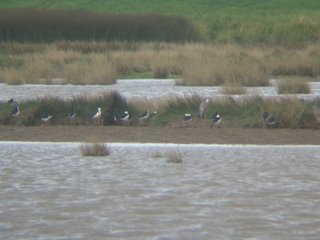 , and the last new NZ bird, Little Black Shag flew over.
During a thrilling 7 hours wait in Los Angeles airport (on our 2nd 18th Feb due to crossing the date line), American Crow and American Herring Gull were seen, but were poor fare after what we had left behind.
New Zealand is a superb place for a holiday, and we only scratched the surface of the birding possibilities. Wildlife/ eco tourism is big, and the infrastructure of transport and accommodation making travelling easy. The locals were very welcoming and nothing was too much trouble for those we dealt with. The weather was decent, and the local food and wine excellent. A fantastic holiday, and hopefully not our last visit.
, and the last new NZ bird, Little Black Shag flew over.
During a thrilling 7 hours wait in Los Angeles airport (on our 2nd 18th Feb due to crossing the date line), American Crow and American Herring Gull were seen, but were poor fare after what we had left behind.
New Zealand is a superb place for a holiday, and we only scratched the surface of the birding possibilities. Wildlife/ eco tourism is big, and the infrastructure of transport and accommodation making travelling easy. The locals were very welcoming and nothing was too much trouble for those we dealt with. The weather was decent, and the local food and wine excellent. A fantastic holiday, and hopefully not our last visit.








